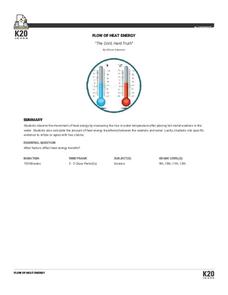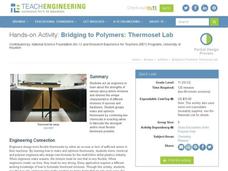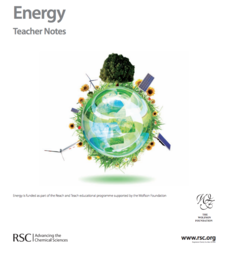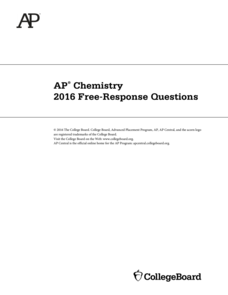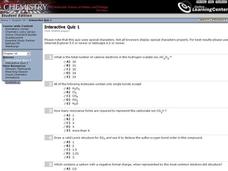Curated OER
Thermodynamic Reaction Worksheet
In this thermodynamics worksheet, students predict the change in reaction values for the 14 thermodynamic reactions given.
Curated OER
Hess's Law
In this reactions activity, students use Hess's Law to calculate the heat gained or lost by different reactions. Students determine if the reaction would occur spontaneously at a given temperature. This activity has 9 problems to solve.
Curated OER
Entropy and Free Energy
In this entropy worksheet, students define entropy and determine if reactions are exothermic or would occur spontaneously. This worksheet has 10 problems to solve.
Curated OER
Version 001 - Quiz 1
The phase diagram tops this chemistry quiz. Junior scientists answer eight multiple-choice questions as they analyze it and make calculations regarding the heat of vaporization.
American Chemical Society
Energy Foundations
Only 10 percent of an incandescent bulb's energy is used to create light; the remaining 90 percent is heat. In the unit of activities, young chemists examine energy through hands-on activities, videos, discussions, and readings. Scholars...
Curated OER
Energy and Enthalpy
In this energy worksheet, students calculate the specific heat and the melting point of titanium. Students calculate the energy released and compare the energetics for given reactions. This worksheet has 4 word problems.
K20 LEARN
The Cold, Hard Truth
Things are really getting heated in the lab! Science scholars scope out the facts about heat energy transfer using a simple lab from the K20 Center. Groups collaborate to observe temperature changes between hot metal and water, then use...
Chemistry Collective
Virtual Lab: ATP Reaction (Thermochemistry and Bonding)
If you've ever felt a little drained ... try converting some ATP to ADP! Science scholars perform one of life's most important reactions using a simulated lab workbench. The fun-to-use interactive allows pupils to control the reactants...
National Institute of Open Schooling
Periodic Table and Atomic Properties
An in-depth lesson, the fourth activity in a series of 36, begins with teaching how the periodic table's arrangement came to its current design. Using this knowledge, pupils then move on to analyze the arrangement of elements to their...
Teach Engineering
Bridging to Polymers: Thermoset Lab
Investigate thermoset polymers through experimentation. In an effort to determine the strongest, most flexible mixture, groups conduct an experiment on different-ratio epoxy-amine polymers to finish the set of two lessons.
Teach Engineering
Close Encounters of the Polymer Kind
A PowerPoint presents features of polymers and two of its categories (thermoplastics and thermosets). Instructors conduct demonstrations to illustrate the Weissenberg Effect and the Barus & Kaye Effects of polymers in the first of...
Royal Society of Chemistry
Energy—Gifted and Talented Chemistry
What has more energy than a room full of pupils after a fire drill? This lesson plan! Explore the changes in energy during different chemical reactions, discover why some reactions feel cold and others feel hot, and tackle the concept of...
Chemistry Collective
Virtual Lab: Measuring the Heat Capacity of an Engine Coolant
Combine automotive science with chemistry! Young scholars investigate an alternative to the traditional engine coolant. They mix the chemicals virtually and collect data to determine the specific heat capacity.
Chemistry Collective
Virtual Lab: Determining the Heat of Reaction in Aqueous Solution
It's gettin' hot in here! An investigative activity has learners measure the heat of reaction in a virtual setting. After exploring the reaction, they attempt to create a solution at an exact temperature.
Chemistry Collective
Virtual Lab: Coffee Problem
Would you like milk with that? Young scientists consider thermal energy transfer to create the perfect cup of coffee. They calculate the amount of milk needed to reach a specified temperature and then test their calculations using a...
College Board
2016 AP® Chemistry Free-Response Questions
The College Board published the mean score on the 2016 AP Chemistry exam as a 2.69, but a minimum of a three is required to earn college credit. Help pupils study for the upcoming exam with actual test questions, sample answers, and...
College Board
2017 AP® Chemistry Free-Response Questions
More than 83,000 scholars earned college credit, thus saving time and money by passing the AP Chemistry exam in 2017. Use the exact test questions covering concepts from activation energy to solubility to prepare for the upcoming...
Curated OER
AP Chemistry-Thermochemistry
In this thermochemistry worksheet, students answer twenty multiple choice questions about heat, enthalpy changes, thermal, mechanical and electrical energy and the laws of thermodynamics.
Curated OER
Chemistry and Bonding
In this bonding worksheet, high schoolers take an interactive quiz with 15 multiple choice questions about the VSEPR Theory, bonding, the geometry of molecules, Lewis structures, resonance structures and enthalpy changes.
Curated OER
Chemical Reactions
In this chemical reactions worksheet, students determine the half-life of a chemical compound for a decomposition reaction. Students determine the activation energy for the reverse of a reaction. This worksheet has 2 problems to solve.
Royal Society of Chemistry
A Reversible Reaction of Hydrated Copper (II) Sulfate
How can removing water change the color of a substance? Lab partners remove the water of crystallization from hydrated copper (II) sulfate, record their observations, then rehydrate the solid. The resource is printable and contains ideas...
Curated OER
Thermochemistry
Learners begin familiarizing themselves with the concept of energy, systems and state functions. They are introduced to the following concepts: Conservation of Energy, Systems, Heat, Entropy, Enthalpy, and Gibbs Free Energy.
Curated OER
Le Chatelier's Principle
For this chemical equilibrium worksheet, young scholars review Le Chatelier's Principle and predict the direction of equilibrium shift for different changes to a chemical reactions. Students also review enthalpy and entropy. This...
Curated OER
Review for Thermodynamics Quiz
In this thermodynamics worksheet, students review kinetic and potential energy, enthalpy, entropy, and standard hear of formation. This worksheet has 1 short answer and 5 problem solving questions.
Other popular searches
- Enthalpy Change
- Entropy Enthalpy
- Combustion Enthalpy
- Enthalpy of Solution
- Chemistry Enthalpy
- Enthalpy and Entropy
- Bondy Enthalpy
- Standard Bond Enthalpy
- Enthalpy of Combustion
- Enthalpy vs Entropy
- Enthalpy of Formation
- Enthalpy and Enthropy








